change time FIAT FIORINO 2019 Owner handbook (in English)
[x] Cancel search | Manufacturer: FIAT, Model Year: 2019, Model line: FIORINO, Model: FIAT FIORINO 2019Pages: 220, PDF Size: 6.22 MB
Page 25 of 220
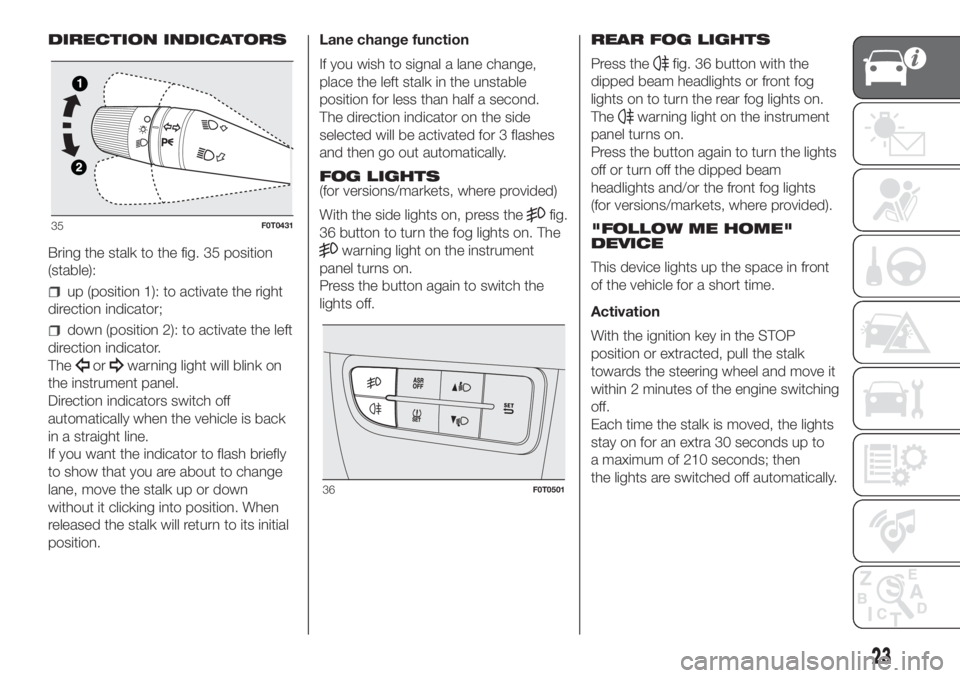
DIRECTION INDICATORS
Bring the stalk to the fig. 35 position
(stable):
up (position 1): to activate the right
direction indicator;
down (position 2): to activate the left
direction indicator.
The
orwarning light will blink on
the instrument panel.
Direction indicators switch off
automatically when the vehicle is back
in a straight line.
If you want the indicator to flash briefly
to show that you are about to change
lane, move the stalk up or down
without it clicking into position. When
released the stalk will return to its initial
position.Lane change function
If you wish to signal a lane change,
place the left stalk in the unstable
position for less than half a second.
The direction indicator on the side
selected will be activated for 3 flashes
and then go out automatically.
FOG LIGHTS
(for versions/markets, where provided)
With the side lights on, press the
fig.
36 button to turn the fog lights on. The
warning light on the instrument
panel turns on.
Press the button again to switch the
lights off.REAR FOG LIGHTS
Press the
fig. 36 button with the
dipped beam headlights or front fog
lights on to turn the rear fog lights on.
The
warning light on the instrument
panel turns on.
Press the button again to turn the lights
off or turn off the dipped beam
headlights and/or the front fog lights
(for versions/markets, where provided).
"FOLLOW ME HOME"
DEVICE
This device lights up the space in front
of the vehicle for a short time.
Activation
With the ignition key in the STOP
position or extracted, pull the stalk
towards the steering wheel and move it
within 2 minutes of the engine switching
off.
Each time the stalk is moved, the lights
stay on for an extra 30 seconds up to
a maximum of 210 seconds; then
the lights are switched off automatically.
35F0T0431
36F0T0501
23
Page 39 of 220
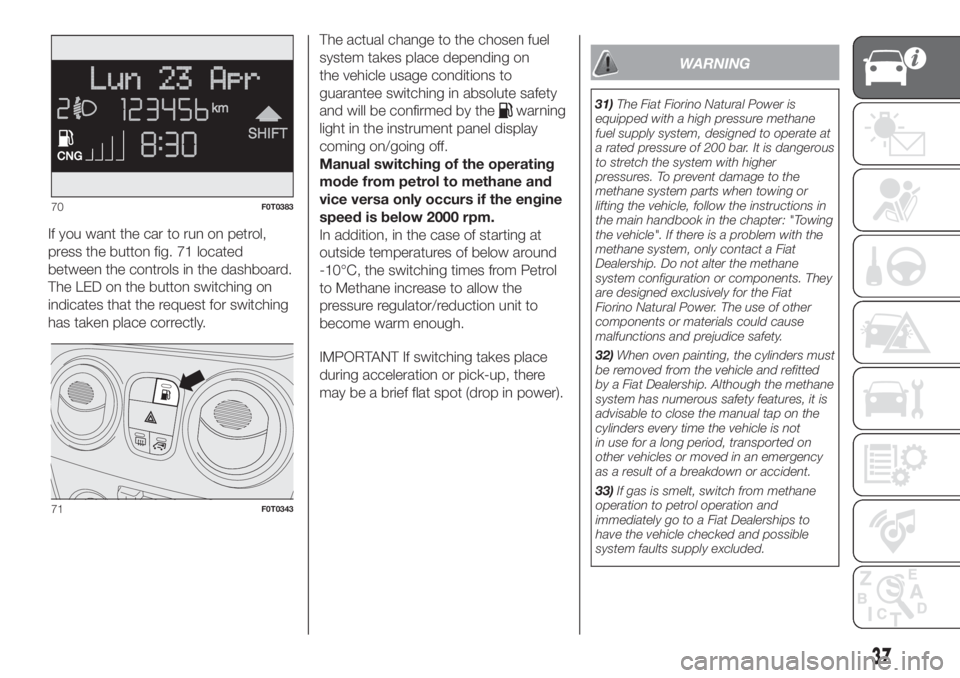
If you want the car to run on petrol,
press the button fig. 71 located
between the controls in the dashboard.
The LED on the button switching on
indicates that the request for switching
has taken place correctly.The actual change to the chosen fuel
system takes place depending on
the vehicle usage conditions to
guarantee switching in absolute safety
and will be confirmed by the
warning
light in the instrument panel display
coming on/going off.
Manual switching of the operating
mode from petrol to methane and
vice versa only occurs if the engine
speed is below 2000 rpm.
In addition, in the case of starting at
outside temperatures of below around
-10°C, the switching times from Petrol
to Methane increase to allow the
pressure regulator/reduction unit to
become warm enough.
IMPORTANT If switching takes place
during acceleration or pick-up, there
may be a brief flat spot (drop in power).
WARNING
31)The Fiat Fiorino Natural Power is
equipped with a high pressure methane
fuel supply system, designed to operate at
a rated pressure of 200 bar. It is dangerous
to stretch the system with higher
pressures. To prevent damage to the
methane system parts when towing or
lifting the vehicle, follow the instructions in
the main handbook in the chapter: "Towing
the vehicle". If there is a problem with the
methane system, only contact a Fiat
Dealership. Do not alter the methane
system configuration or components. They
are designed exclusively for the Fiat
Fiorino Natural Power. The use of other
components or materials could cause
malfunctions and prejudice safety.
32)When oven painting, the cylinders must
be removed from the vehicle and refitted
by a Fiat Dealership. Although the methane
system has numerous safety features, it is
advisable to close the manual tap on the
cylinders every time the vehicle is not
in use for a long period, transported on
other vehicles or moved in an emergency
as a result of a breakdown or accident.
33)If gas is smelt, switch from methane
operation to petrol operation and
immediately go to a Fiat Dealerships to
have the vehicle checked and possible
system faults supply excluded.
70F0T0383
71F0T0343
37
Page 56 of 220

WARNING
34)If thewarning light turns on while driving (on certain versions together with the message on the display) stop the car immediately and
contact a Fiat Dealership.
35)The warning light
may not light up when the key is turned to MAR or stay on while travelling to indicate a retaining system fault. In this
case, the airbags or the pretensioners may not be activated in the case of an accident or (in a lesser number of cases) they may be activated
incorrectly. Before continuing, contact a Fiat Dealership to have the system checked immediately.
36)A failure of the
warning light is indicated by thewarning light flashing or, depending on the version, by theicon turning on
continuously on the display. In this case, thewarning light may not indicate a possible problem with the airbag restraint system. Before
continuing, contact a Fiat Dealership to have the system checked immediately.
37)If the
warning light switches on when travelling (on certain versions together with the message on the display), stop the engine
immediately and contact a Fiat Dealership.
WARNING
9)If the warning light switches on, the degraded engine oil must be changed as soon as possible, and never more than 500 km from the first
time that the warning light switches on. Failure to observe the above may result in severe damage to the engine and invalidate the warranty.
The activation of this warning light is not related to the amount of oil in the engine. Therefore, never top up with oil when the warning light
starts flashing.
54
KNOWING THE INSTRUMENT PANEL
Page 78 of 220

52)Do not take unnecessary risks, even if
your vehicle is fitted with this system.
Your driving style must always be suited to
the road conditions, visibility and traffic.
The driver is always responsible for road
safety.
53)The HBA system cannot overrule the
natural laws of physics, and cannot
increase the grip available according to the
condition of the road.
54)The HBA system cannot prevent
accidents, including those due to excessive
speed on corners, driving on low-grip
surfaces or aquaplaning.
55)The capability of the HBA must never
be tested irresponsibly and dangerously, in
such a way as to compromise personal
safety and the safety of others.iTPMS System
(indirect Tyre
Pressure
Monitoring System)
(for versions/markets, where provided)
The indirect Tyre Pressure Monitoring
System iTPMS can monitor the tyre
inflation status through the wheel speed
sensors. The system warns the driver
if one or more tyres are flat by switching
on the
warning light on the
instrument panel and a warning
message on the display, along with an
acoustic signal.
It is advisable to check the pressure of
all four tyres. This indication is displayed
also when turning the engine off and
on until the “Reset” procedure is carried
out.
“Reset” procedure
The iTPMS needs an initial "self-
learning" phase (with length depending
on the driving style and road conditions:
optimal conditions being driving on a
straight road at 80 km/h for at least 20
minutes) which starts when the “Reset”
procedure is carried out.
The “Reset” procedure must be carried
out:
each time tyre pressure is modified;
when even only one tyre is changed;
when tyres are rotated/inverted;
when the space-saver wheel is
fitted. Before carrying out the “Reset”
procedure, inflate the tyres to the rated
pressure values specified in the inflation
pressure table (see "Wheels" paragraph
in the "Technical specifications"
chapter).
If the “Reset” procedure is not carried
out, in all above cases, the
warning
light may give false indications on
one or more tyres.
To carry out the “Reset” procedure,
with the vehicle stopped and the
ignition device at MAR, use the Setup
Menu as follows:
briefly press thebutton: the
display will show "Reset";
press thebutton or the
button to select ("Yes" or "No");
briefly press thebutton: the
display will show "Confirm";
pressbutton orto select
("Yes" to “Reset” or "No" to exit the
video page);
press thebutton again to return
to the standard screen or to the main
menu according to where you are in the
menu.
After the “Reset” the display will show
the "Reset saved" message, indicating
that the "self-learning" has been
started.
76
SAFETY
Page 82 of 220

IMPORTANT The “red band” on the
levers A fig. 86 used for folding the seat
will not appear when the backrest is
correctly secured. This red band
indicates that the backrest is
not secured.
IMPORTANT After putting the rear
seats (for versions/markets, where
provided) back to their normal
operating position, re-position the seat
belt so that it is immediately ready for
the next use.
68)
WARNING
66)Never press button C fig. 83when
travelling.
67)Remember that in the event of a violent
impact the rear seat passengers not
wearing seat belts are exposed to a very
serious risk and also represent a serious
danger for the front seat occupants.
68)Make sure the backrest is properly
secured at both sides (”red bands” not
visible) to prevent it moving forward in the
event of sharp braking, causing injuries
to passengers.
SBR SYSTEM
(for versions/markets, where provided)
The vehicle is equipped with a system
called S.B.R. (Seat Belt Reminder),
which warns the driver and front
passenger (for versions/markets, where
provided) if their seat belt is not
fastened, as follows:
warning lightcomes on
continuously on the instrument panel
and the buzzer sounds continuously for
the first 6 seconds;
warning lightflashes on the
instrument panel and the buzzer
sounds intermittently for the following
90 seconds.
For permanent deactivation, contact a
Fiat Dealership.
The SBR system can also be
reactivated through the setup menu.
PRE-TENSIONERS
To increase the protective efficiency of
the front seat belts, the vehicle is fitted
with pretensioners. These devices, in
the event of a violent frontal collision or
side collision, rewind the seat belts a
few centimetres. In this way, they
ensure that the belts fit tightly to the
wearer before the restraining action
begins.
It is evident that the pretensioners have
been activated when the belt withdraws
toward the retractor.
IMPORTANT To obtain the highest
degree of protection from the action of
the pretensioner, wear the seat belt
tight to the chest and pelvis.
A slight discharge of smoke may be
produced during the activation of the
pretensioner which is not harmful and
does not involve any fire hazard.
The pretensioner does not require any
maintenance or lubrication. Any
changes to its original conditions will
invalidate its efficiency. If, due to
unusual natural events (floods, sea
storms, etc.), the device has been
affected by water and mud, it must
absolutely be replaced.
69) 70)
12)
80
SAFETY
Page 104 of 220
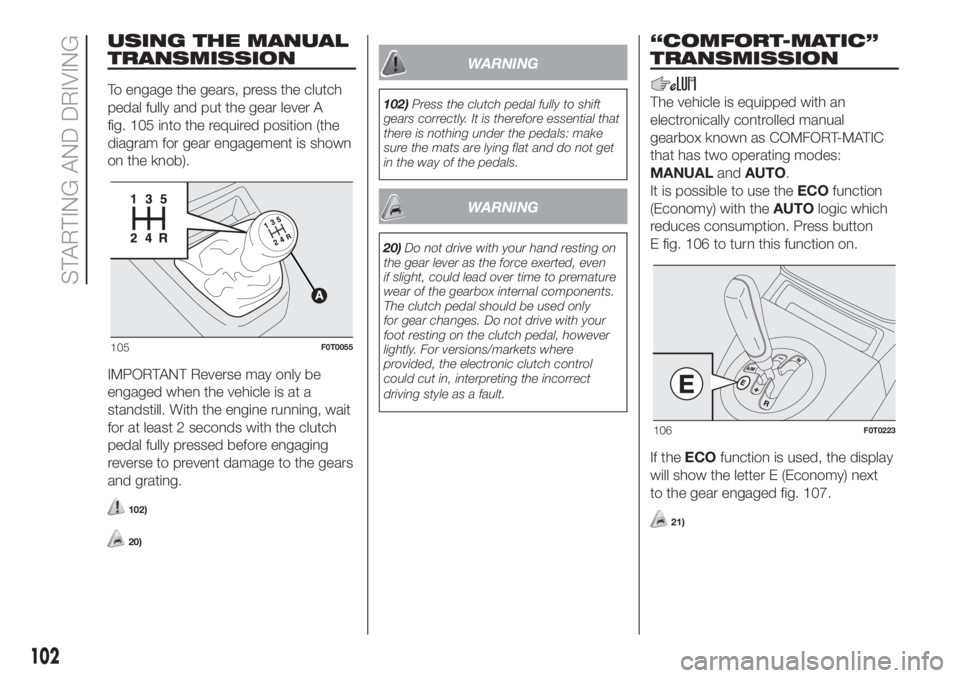
USING THE MANUAL
TRANSMISSION
To engage the gears, press the clutch
pedal fully and put the gear lever A
fig. 105 into the required position (the
diagram for gear engagement is shown
on the knob).
IMPORTANT Reverse may only be
engaged when the vehicle is at a
standstill. With the engine running, wait
for at least 2 seconds with the clutch
pedal fully pressed before engaging
reverse to prevent damage to the gears
and grating.
102)
20)
WARNING
102)Press the clutch pedal fully to shift
gears correctly. It is therefore essential that
there is nothing under the pedals: make
sure the mats are lying flat and do not get
in the way of the pedals.
WARNING
20)Do not drive with your hand resting on
the gear lever as the force exerted, even
if slight, could lead over time to premature
wear of the gearbox internal components.
The clutch pedal should be used only
for gear changes. Do not drive with your
foot resting on the clutch pedal, however
lightly. For versions/markets where
provided, the electronic clutch control
could cut in, interpreting the incorrect
driving style as a fault.
“COMFORT-MATIC”
TRANSMISSION
The vehicle is equipped with an
electronically controlled manual
gearbox known as COMFORT-MATIC
that has two operating modes:
MANUALandAUTO.
It is possible to use theECOfunction
(Economy) with theAUTOlogic which
reduces consumption. Press button
E fig. 106 to turn this function on.
If theECOfunction is used, the display
will show the letter E (Economy) next
to the gear engaged fig. 107.
21)
105F0T0055
106F0T0223
102
STARTING AND DRIVING
Page 106 of 220

CRUISE CONTROL
(constant speed
regulator)
(for versions/markets, where provided)
This is an electronic driving aid that
allows you to drive at a speed of above
30 km/h on long and straight dry roads
with few driving changes (e.g.
motorways) at a preset speed without
having to press the accelerator pedal. It
is therefore not recommended to use
this device on extra-urban roads with
traffic. Do not use the device in town.
Turning the device on
When the device is activated, light
comes on together with the relevant
message on the instrument panel (for
versions/markets, where provided).
The speed adjustment function cannot
be activated in 1
stor reverse gear; it
is advisable to activate the function in
4
thor higher gears.
When travelling downhill with the device
activated, the vehicle speed may
exceed the memorised one.
Storing vehicle speed
Proceed as follows:
turn ring nut A fig. 111 to the ON
position and press the accelerator
pedal so that the vehicle reaches the
desired speed;
move the stalk upwards (+) for at
least one second, then release it. The
vehicle speed is now stored and you
can therefore release the accelerator
pedal.
If necessary (e.g. when overtaking)
acceleration is possible by simply
pressing the accelerator pedal:
releasing the accelerator pedal the car
will return to the speed stored
previously.
Restoring the stored speed
If the device has been deactivated, for
example by depressing the brake or
clutch pedal, the stored speed can be
restored as follows:
accelerate progressively until a
speed close to that stored is reached;
engage the gear selected at the time
that the speed was stored;
press button B fig. 111.Increasing the stored speed
This can be done in two ways:
by pressing the accelerator and
storing the new speed reached
or
by moving the stalk upwards (+).
Each activation of the lever
corresponds to an increase in speed of
about 1 km/h, whilst keeping the lever
upwards varies the speed continuously.
Reducing the memorised speed
This can be done in two ways:
by deactivating the device and then
storing the new speed
or
by moving the stalk downwards (-)
until the new speed, which will be
stored automatically, is reached.
Each movement of the stalk will
correspond to a slight reduction in
speed of about 1 km/h, while keeping
the stalk held downwards will decrease
the speed continuously.
Turning the device off
The device can be switched off by the
driver in the following ways:
by turning ring nut A to the OFF
position;
by switching off the engine;
111F0T0405
104
STARTING AND DRIVING
Page 108 of 220

PARKING SENSORS
(for versions/markets, where provided)
105)
22) 23) 24)
The parking sensors, located in the rear
bumper fig. 113 , are used to detect
the presence of any obstacles near the
rear part of the vehicle. The sensors
by means of intermittent acoustic
indication warn the driver of the
presence of obstacles.
ACTIVATION/
DEACTIVATION
The sensors are automatically activated
when reverse gear is engaged.
The buzzer becomes more frequent as
the obstacle behind the vehicle gets
closer to the bumper.ACOUSTIC SIGNAL
When reverse gear is engaged an
intermittent acoustic signal is
automatically activated.
The frequency of the acoustic warning:
increases as the distance between
the vehicle and the obstacle decreases;
become continuous when the
distance between the vehicle and the
obstacle is less than 30 cm and stop
immediately if the distance increases;
it remains constant if the distance
remains unchanged; if this situation
concerns the side sensors, the buzzer
will stop after about 3 seconds to
avoid, for example, warning indications
in the event of manoeuvres along
walls.
Detection distances
If several obstacles are detected by the
sensors, only the nearest one is
considered.
FAULT INDICATIONS
Any parking sensor failures will be
indicated when engaging reverse by the
warning light
in the instrument
panel together with the message in the
multifunction display (for versions/
markets where provided) (see “Warning
lights and messages” section in the
"Knowing the instrument panel"
chapter).OPERATION WITH A
TRAILER
The operation of the sensors is
automatically deactivated when the
trailer's electrical connection is inserted
in the vehicle tow hook socket. Sensors
are reactivated on removing the
trailer's electrical connection.
IMPORTANT NOTES
During parking manoeuvres, pay the
utmost attention to any obstacles that
could be located above or below the
sensors.
Sometimes, objects located very
near the rear of the vehicle are not
detected and could therefore damage
the vehicle or be damaged themselves.
The signals sent out by the sensors
can be altered by dirt, snow or ice
deposited on the sensors or by
ultrasound systems (e.g. truck
pneumatic brakes or pneumatic drills)
near the vehicle.
The parking sensors work properly
with the swing doors closed. If they are
open, they can cause the system to
send false signals: always close the rear
doors.
Also, do not apply stickers to the
sensors.
113F0T0155
106
STARTING AND DRIVING
Page 159 of 220
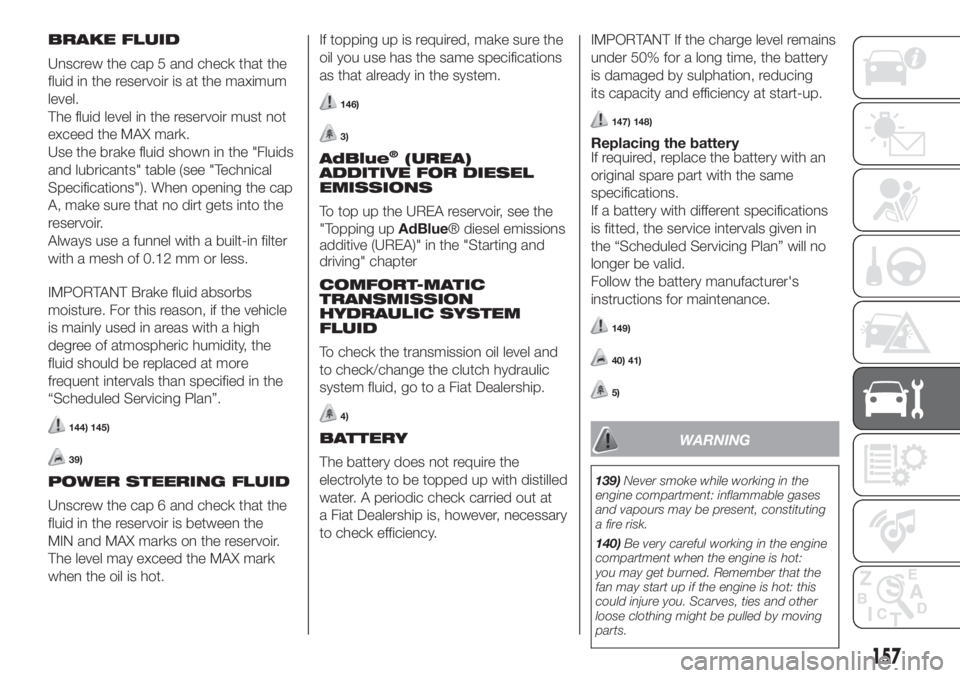
BRAKE FLUID
Unscrew the cap 5 and check that the
fluid in the reservoir is at the maximum
level.
The fluid level in the reservoir must not
exceed the MAX mark.
Use the brake fluid shown in the "Fluids
and lubricants" table (see "Technical
Specifications"). When opening the cap
A, make sure that no dirt gets into the
reservoir.
Always use a funnel with a built-in filter
with a mesh of 0.12 mm or less.
IMPORTANT Brake fluid absorbs
moisture. For this reason, if the vehicle
is mainly used in areas with a high
degree of atmospheric humidity, the
fluid should be replaced at more
frequent intervals than specified in the
“Scheduled Servicing Plan”.
144) 145)
39)
POWER STEERING FLUID
Unscrew the cap 6 and check that the
fluid in the reservoir is between the
MIN and MAX marks on the reservoir.
The level may exceed the MAX mark
when the oil is hot.If topping up is required, make sure the
oil you use has the same specifications
as that already in the system.
146)
3)
AdBlue®(UREA)
ADDITIVE FOR DIESEL
EMISSIONS
To top up the UREA reservoir, see the
"Topping upAdBlue® diesel emissions
additive (UREA)" in the "Starting and
driving" chapter
COMFORT-MATIC
TRANSMISSION
HYDRAULIC SYSTEM
FLUID
To check the transmission oil level and
to check/change the clutch hydraulic
system fluid, go to a Fiat Dealership.
4)
BATTERY
The battery does not require the
electrolyte to be topped up with distilled
water. A periodic check carried out at
a Fiat Dealership is, however, necessary
to check efficiency.IMPORTANT If the charge level remains
under 50% for a long time, the battery
is damaged by sulphation, reducing
its capacity and efficiency at start-up.
147) 148)
Replacing the battery
If required, replace the battery with an
original spare part with the same
specifications.
If a battery with different specifications
is fitted, the service intervals given in
the “Scheduled Servicing Plan” will no
longer be valid.
Follow the battery manufacturer's
instructions for maintenance.
149)
40) 41)
5)
WARNING
139)Never smoke while working in the
engine compartment: inflammable gases
and vapours may be present, constituting
a fire risk.
140)Be very careful working in the engine
compartment when the engine is hot:
you may get burned. Remember that the
fan may start up if the engine is hot: this
could injure you. Scarves, ties and other
loose clothing might be pulled by moving
parts.
157
Page 160 of 220
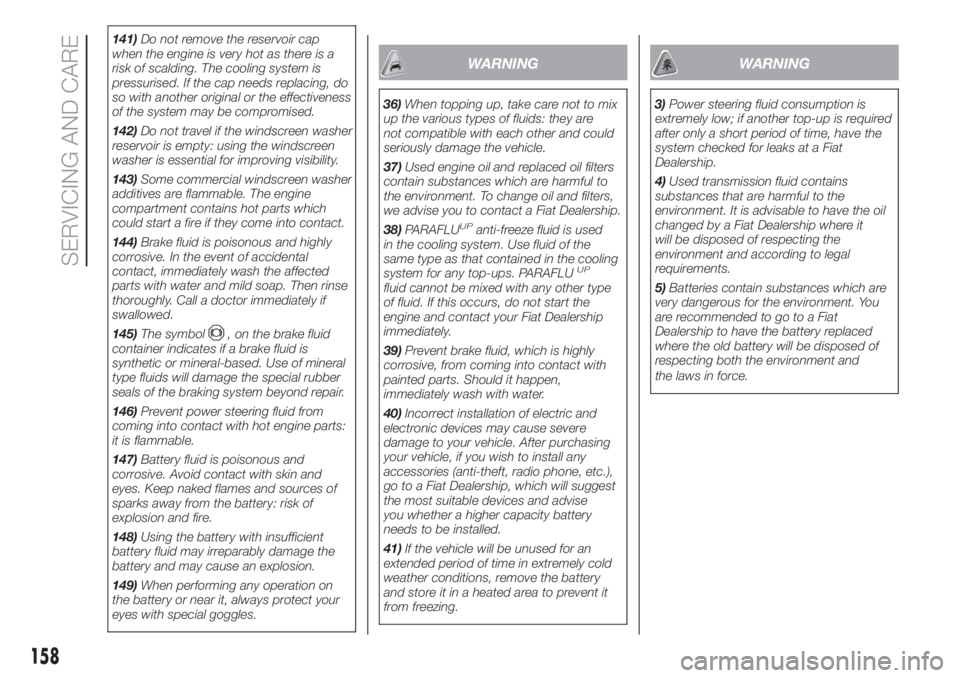
141)Do not remove the reservoir cap
when the engine is very hot as there is a
risk of scalding. The cooling system is
pressurised. If the cap needs replacing, do
so with another original or the effectiveness
of the system may be compromised.
142)Do not travel if the windscreen washer
reservoir is empty: using the windscreen
washer is essential for improving visibility.
143)Some commercial windscreen washer
additives are flammable. The engine
compartment contains hot parts which
could start a fire if they come into contact.
144)Brake fluid is poisonous and highly
corrosive. In the event of accidental
contact, immediately wash the affected
parts with water and mild soap. Then rinse
thoroughly. Call a doctor immediately if
swallowed.
145)The symbol
, on the brake fluid
container indicates if a brake fluid is
synthetic or mineralbased. Use of mineral
type fluids will damage the special rubber
seals of the braking system beyond repair.
146)Prevent power steering fluid from
coming into contact with hot engine parts:
it is flammable.
147)Battery fluid is poisonous and
corrosive. Avoid contact with skin and
eyes. Keep naked flames and sources of
sparks away from the battery: risk of
explosion and fire.
148)Using the battery with insufficient
battery fluid may irreparably damage the
battery and may cause an explosion.
149)When performing any operation on
the battery or near it, always protect your
eyes with special goggles.
WARNING
36)When topping up, take care not to mix
up the various types of fluids: they are
not compatible with each other and could
seriously damage the vehicle.
37)Used engine oil and replaced oil filters
contain substances which are harmful to
the environment. To change oil and filters,
we advise you to contact a Fiat Dealership.
38)PARAFLU
UPanti-freeze fluid is used
in the cooling system. Use fluid of the
same type as that contained in the cooling
system for any top-ups. PARAFLU
UP
fluid cannot be mixed with any other type
of fluid. If this occurs, do not start the
engine and contact your Fiat Dealership
immediately.
39)Prevent brake fluid, which is highly
corrosive, from coming into contact with
painted parts. Should it happen,
immediately wash with water.
40)Incorrect installation of electric and
electronic devices may cause severe
damage to your vehicle. After purchasing
your vehicle, if you wish to install any
accessories (anti-theft, radio phone, etc.),
go to a Fiat Dealership, which will suggest
the most suitable devices and advise
you whether a higher capacity battery
needs to be installed.
41)If the vehicle will be unused for an
extended period of time in extremely cold
weather conditions, remove the battery
and store it in a heated area to prevent it
from freezing.
WARNING
3)Power steering fluid consumption is
extremely low; if another top-up is required
after only a short period of time, have the
system checked for leaks at a Fiat
Dealership.
4)Used transmission fluid contains
substances that are harmful to the
environment. It is advisable to have the oil
changed by a Fiat Dealership where it
will be disposed of respecting the
environment and according to legal
requirements.
5)Batteries contain substances which are
very dangerous for the environment. You
are recommended to go to a Fiat
Dealership to have the battery replaced
where the old battery will be disposed of
respecting both the environment and
the laws in force.
158
SERVICING AND CARE